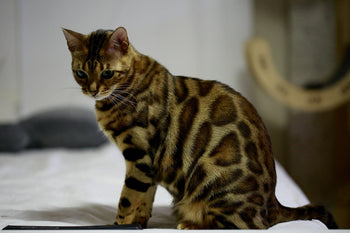Turkish Angora is a breed of domestic cat that originated in Turkey. This elegant and graceful breed is known for its long, silky white fur and bright blue or green eyes. Turkish Angora cats have a long and fascinating history that dates back to ancient times.
The Turkish Angora breed has evolved over time due to natural selection in Anatolia, Turkey. It was specifically chosen by cat enthusiasts for its exquisite coat in order to enhance the Persian breed. In the 1960s, the Angora found its way to the United States and Canada. The Cat Fanciers' Association in the U.S. officially acknowledged this breed in 1963, initially accepting only white Angoras until 1978. Presently, various coat colors and patterns of Turkish Angoras are recognized by cat registries throughout the United States.
In this article, we will explore the characteristics of Turkish Angora cats, their role in art and culture, and how to care for them. We will also answer some frequently asked questions about this breed. Whether you're a cat lover or simply interested in learning more about different cat breeds, this article will provide you with valuable insights into the world of Turkish Angora cats.

Turkish Angora Cats: Characteristics, History, and Care
Key Takeaways
Turkish Angora cats are known for their long, silky white fur and bright blue or green eyes.
This breed has a long and fascinating history that dates back to ancient times.
To care for a Turkish Angora cat, it's important to provide them with regular grooming, exercise, and a healthy diet.
Characteristics of Turkish Angora Cats
The Turkish Angora originates from Turkey and is believed to be the source of the genetic mutation responsible for white coat color and long hair in domestic cats. These cats have elegant, silky long coats and move with agility and grace. They have small, round heads, wide-set ears, almond-shaped eyes of various colors, and heterochromia is occasionally seen. While they are most famous for their shimmering white coats, Turkish Angoras can also have tabby coats (brown or white), black with a chocolate brown undercoat, or a variety of stunning smoke tones.
Turkish Angora Cats are a unique breed with distinct features that set them apart from other cats. Here are some of the characteristics that make them stand out:
Long, Silky Coat and Various Color Patterns
Turkish Angora Cats have a long, silky coat that requires regular grooming to keep it in good condition. They come in various colors and patterns, including white, black, blue, cream, and red. Some Turkish Angoras have two-toned coats or tabby patterns.
Playful and Intelligent Nature
Turkish Angora Cats are known for their playful and intelligent nature. They are active and curious, and enjoy playing with toys and interacting with their owners. They are also highly trainable and can learn tricks and commands.
Health Considerations and Grooming Tips for Turkish Angoras
Turkish Angoras, especially those with white fur and blue eyes, are more prone to congenital deafness caused by a mutation in the KIT gene. As hearing loss worsens, this can result in louder vocalization than usual. In comparison to other breeds, Turkish Angora kittens are more likely to have heterochromia. There is a possibility that this breed is at a higher risk of congenital ataxia, a deadly condition characterized by uncoordinated movements and tremors. Additionally, they may have an increased risk of hypertrophic cardiomyopathy.
Turkish Angora Cats are generally healthy, but they may be prone to certain health issues, such as deafness and heart disease. It is important to have regular check-ups with a veterinarian to catch any health problems early.
In terms of grooming, Turkish Angoras require regular brushing to prevent matting and to keep their coat shiny and healthy. They also need to have their ears cleaned regularly to prevent infections.
Overall, Turkish Angora Cats are a unique and fascinating breed with many positive traits. With proper care and attention, they can make wonderful companions for cat lovers.

Turkish Angora Fun Facts
This feline is often referred to as the ballerina of the cat world because of its graceful movements and impressive agility.
This particular feline family is quite fond of seeking attention. The domestic cat belonging to this family is exceedingly affable and full of energy. They thoroughly enjoy engaging in activities such as moving, running, climbing, and playing. It wouldn't be unusual to discover your Turkish Angora perched atop the refrigerator! Due to their lively nature and amiable disposition, this petite companion can be quite insistent when it comes to seeking attention.
The Turkish Angora's opulent and velvety long coat is low-maintenance, as it rarely tangles. This breed surprisingly needs very little grooming, with weekly sessions being adequate to keep their coat clean and healthy.
The Ankara Zoo continues to exhibit this particular breed. Regarded as a national treasure of Turkey, the Turkish breed is diligently preserved within the confines of the Ankara Zoo, allowing visitors to witness the presence of the breed's authentic representatives.
Turkish Angora in Art and Culture
Depictions of Turkish Angoras in Historical Art and Literature
Turkish Angoras have been a subject of admiration and inspiration in art and literature for centuries. In Ottoman times, these elegant cats were often depicted in paintings and poetry. One famous example is the painting "The Angora Cat" by Osman Hamdi Bey, which portrays a white Turkish Angora with piercing blue eyes. In literature, Turkish Angoras have been mentioned in various works, such as in the book "The White Cat and the Monk" by Jo Ellen Bogart, which tells the story of a monk who befriends a white Turkish Angora.
Symbolism and Significance of Turkish Angoras in Turkish Culture
In Turkish culture, Turkish Angoras are regarded as a symbol of grace, beauty, and purity. They are often associated with the goddess Bastet, who was the patron of cats in ancient Egyptian mythology. Turkish Angoras have also been featured in Turkish folklore, where they are believed to bring good luck and fortune to their owners. In fact, it is said that owning a Turkish Angora is a sign of prosperity and wealth.
Influence of Turkish Angoras on Modern Art and Design
Turkish Angoras continue to inspire artists and designers today. Their striking appearance and unique personality traits have made them a popular subject in contemporary art and design. For example, Turkish Angoras have been featured in fashion campaigns, such as the "Turkish Delight" campaign by Gucci, which showcased models posing with Turkish Angoras. They have also been used as a motif in home décor, such as in the form of embroidered pillows or printed on wallpaper.
In conclusion, Turkish Angoras have played a significant role in art and culture throughout history and continue to do so today. Their beauty and grace have captured the hearts of people around the world, making them a beloved and cherished breed.

Caring for Turkish Angora Cats
Turkish Angora cats are known for their striking beauty and playful personalities. To keep them healthy and happy, it is important to provide proper care, including a balanced diet, regular exercise, and veterinary check-ups. Here are some tips for caring for your Turkish Angora cat.
Diet and Nutrition Recommendations for Turkish Angoras
Turkish Angoras require a high-quality, protein-rich diet to maintain their energy levels and keep their coat healthy. It is recommended to feed them a balanced diet of wet and dry food, with a preference for wet food. Avoid feeding your cat table scraps and human food, as these can cause digestive problems and lead to obesity.
It is also important to provide your Turkish Angora with fresh, clean water at all times. Consider investing in a cat water fountain to encourage your cat to drink more water and stay hydrated.
Exercise and Mental Stimulation for a Happy and Healthy Cat
Turkish Angoras are active and playful cats that require regular exercise and mental stimulation to stay healthy and happy. Provide your cat with toys, scratching posts, and climbing structures to keep them entertained and engaged. Interactive playtime with your cat is also important for bonding and keeping your cat's mind sharp.
Veterinary Care and Common Health Issues to Watch Out For
Regular veterinary check-ups are important for maintaining your Turkish Angora's health. Your vet can provide recommendations for vaccinations, parasite prevention, and dental care.
Turkish Angoras are generally healthy cats, but they may be prone to certain health issues such as deafness and heart problems. It is important to watch out for any signs of illness or discomfort and seek veterinary care if necessary.
Related Posts:
Conclusion
Turkish Angora is a beautiful and elegant breed of cat that has captured the hearts of many cat lovers around the world. Its unique characteristics, including its long, silky coat and striking blue or green eyes, make it a popular choice for those looking for a feline companion that is both attractive and affectionate.
Despite their stunning appearance, Turkish Angoras are also known for their playful and mischievous personalities. They are intelligent cats that enjoy interactive play and will often entertain themselves with toys and games.
One of the most interesting facts about Turkish Angoras is their coat. Unlike many other cat breeds, their coat is not prone to matting or tangling, which makes grooming relatively easy. However, their coat does require regular brushing to keep it in good condition.
Overall, Turkish Angoras are a wonderful breed for those looking for a cat that is both beautiful and fun-loving. With their striking looks and engaging personalities, they are sure to bring joy and companionship to any household.
Frequently Asked Questions
What are the distinguishing characteristics of a Turkish Angora cat?
Turkish Angora cats are known for their distinctive silky, soft, and long fur, which comes in a variety of colors including white, black, blue, and red. They are also known for their triangular-shaped heads, large ears, and long, lean bodies. Turkish Angoras are an elegant and graceful breed, with a playful and curious nature.
What is the typical personality of a Turkish Angora?
Turkish Angoras are known to be intelligent, social, and affectionate cats. They are highly active and enjoy playing, climbing, and exploring their surroundings. They are also known for their vocalization and may meow frequently to communicate with their owners. Turkish Angoras are generally good with children and other pets, but they can be territorial and may require proper socialization.
How much does a Turkish Angora cat typically cost?
The cost of a Turkish Angora cat can vary depending on the breeder, location, and pedigree. On average, a Turkish Angora kitten can cost between $500 and $1500. However, some breeders may charge more for cats with exceptional pedigrees or show-quality cats.
What color variations do Turkish Angora cats come in?
Turkish Angoras come in a variety of colors and patterns, including white, black, blue, red, and cream. Some Turkish Angoras may also have tabby, tortoiseshell, or calico patterns.
Are Turkish Angora cats considered good companions for families?
Turkish Angoras can make excellent companions for families. They are social and affectionate cats that enjoy spending time with their owners. However, they can be high energy and may require regular playtime and exercise. They are also known to be vocal cats, which may not be suitable for all families.
Do Turkish Angora cats require special grooming or care?
Turkish Angoras have long, silky fur that requires regular grooming to prevent matting and tangling. They should be brushed at least once a week, and their fur may need to be trimmed periodically. Turkish Angoras also require regular nail trimming, dental care, and ear cleaning to maintain their health and appearance.















